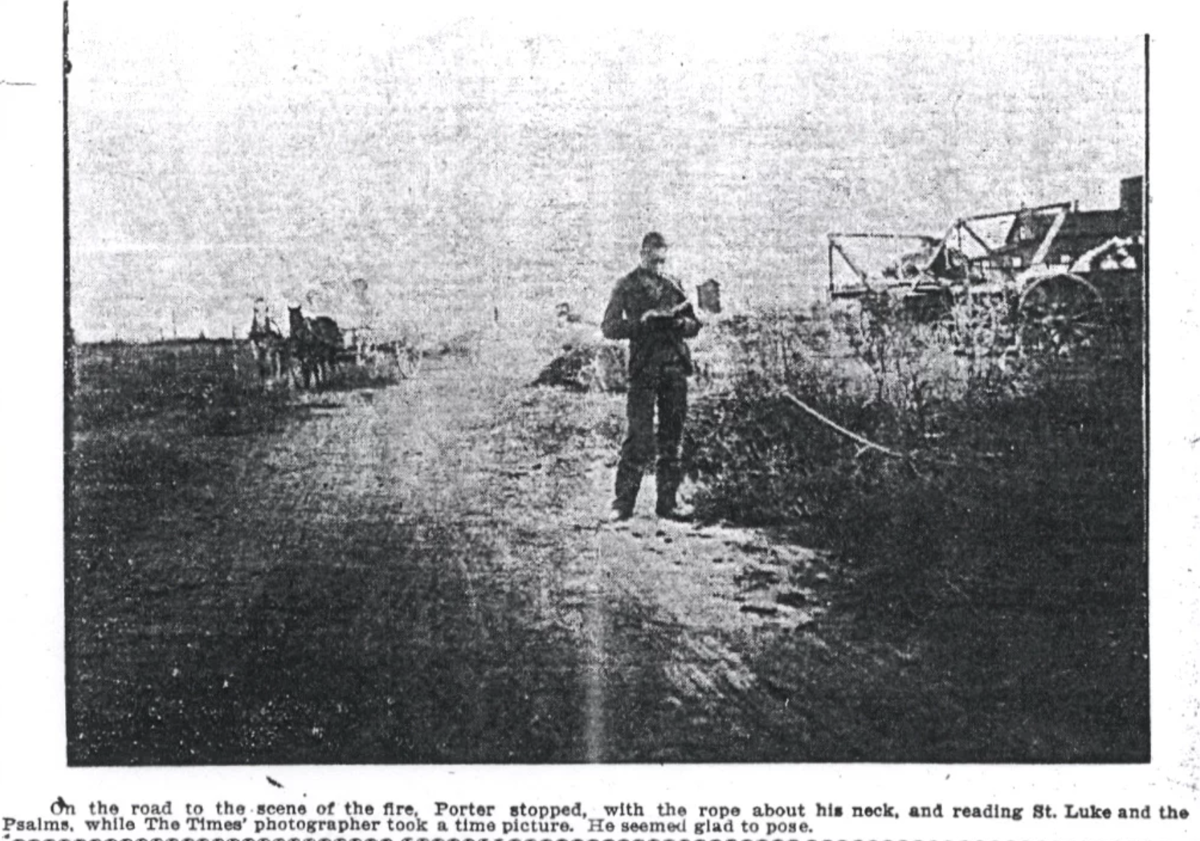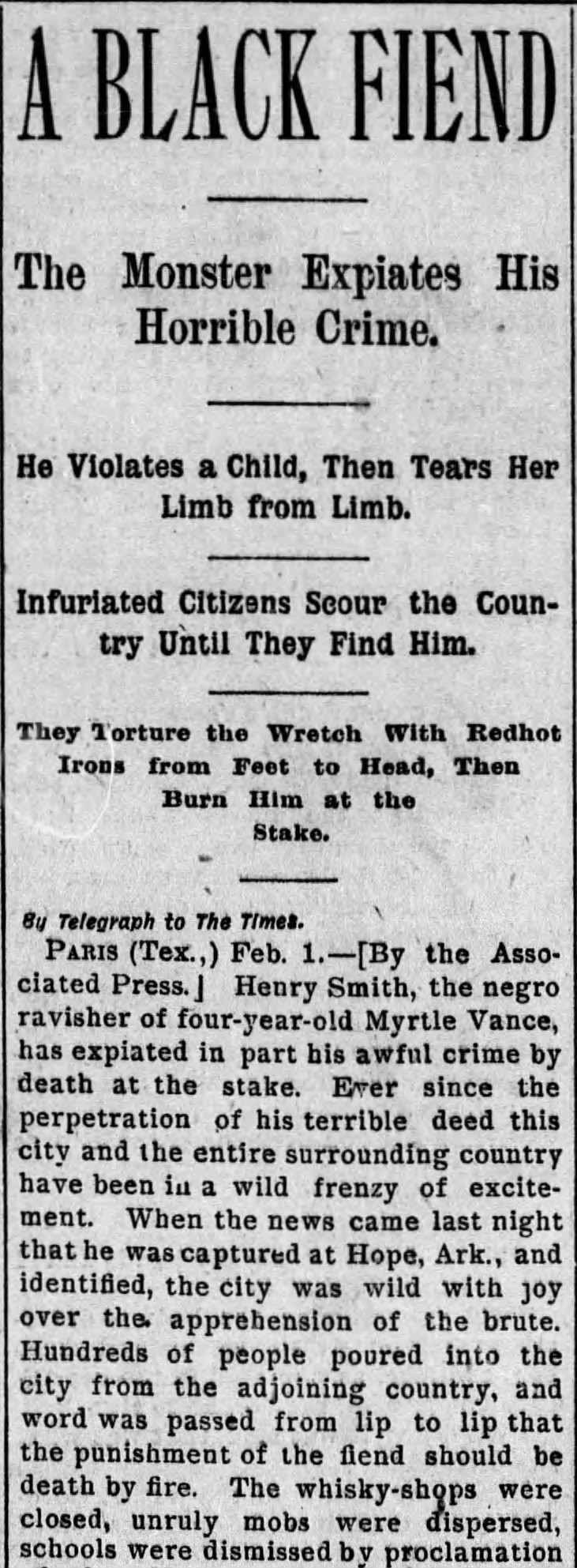By Tatyana Monnay and Eve Sampson
When 17-year-old Henry Smith left Paris, Texas, after being questioned in the rape and murder of a white toddler, a railroad company offered free transportation to anyone who wanted to take part in the manhunt for him.
Scores joined the chase, catching the Black teen in Arkansas and sending him back to a lynching posse in Paris, Texas. On Feb. 1, 1893, the mob tortured Smith with red-hot irons before burning him alive in front of a crowd estimated at 10,000. He had not been charged with the crime.
Newspapers in Los Angeles and Indianapolis ran the Associated Press dispatches about the killing. Other papers also ran the AP story, but didn’t credit the wire service.
This work is a collaboration of the Howard Center for Investigative Journalism and Capital News Service at the University of Maryland, Morgan State University, Hampton University, Howard University, Morehouse College, North Carolina Agricultural & Technical State University and the University of Arkansas.
“Henry Smith, the negro ravisher of four-year-old Myrtle Vance has expiated in part his awful crime by death at the stake,” the stories begin.
“Every train that came in was loaded to its utmost capacity, and there were demands at many points for special trains to bring people here to see the unparalleled punishment of the fiend for his unparalleled crime,” the story reported.
The AP, along with its member papers, reported in depth on these extra-judicial killings by racist, white mobs throughout the late 1800s and 1900s. The news outlets labeled Black men, sometimes without any attribution, as rapists of white women and murderers of white men, women and children. The AP story about Smith, for example, called him a child rapist and murderer without citing any official source.
An analysis of newspaper and wire clippings by the Howard Center for Investigative Journalism at the University of Maryland found AP stories labeled Black lynching victims as fiends, ravishers and monsters in stories distributed to a national audience.
“Some of our past coverage was good. Some of our past coverage is problematic,” said Amanda Barrett, AP vice president and head of news audience. “Looking at it, we have to think about how we want to do differently and think about who’s not in the coverage, whose perspective is left out. And where we need to grow from.”
PRINTING HATE
EXPLORE ALL STORIES
John Daniszewski, AP vice president and editor at large for standards, acknowledged shortcomings in the wire service’s coverage of lynchings and racial terror.
“We know of no instance in which the AP deliberately promoted racist violence,” Daniszewski said in an email to the Howard Center. “However, the AP reported on lynching and other forms of racial violence over many years, sometimes in disturbing detail with flaws and omissions. These shortcomings clearly reflected the attitudes and prejudices of the era in which these reports were written but that is no excuse and we regret them.”
(He provided an identical quote to The Nation for an April 2021 story.)
AP began as a five-member news cooperative in 1846 and now has bureaus and offices in 100 countries. The organization operates as an information hub. News organizations that are members of the cooperative provide stories to AP, which also produces its own reports. The news cooperative distributes both types of stories to AP members.
Daniszewski said AP only has partial records of its lynching coverage from the 19th and early 20th centuries and still needs to learn more about and analyze this coverage.
Then, as today, AP sent reporters to cover news events and picked up stories from member papers for coverage it couldn’t provide itself. Daniszewski said AP did “minimal’’ additional reporting on stories provided by members. But AP was responsible for editing them before sending them out for use around the country.
He noted that AP’s members could change the wording in stories the wire service provided and add their own headlines.
The Howard Center used Newspapers.com to identify AP coverage, then compared the versions used by newspapers to determine whether they had been changed by the local paper.
One of those stories involved the lynching of Preston “John” Porter Jr., 15, who was killed Nov. 16, 1900, near Limon, Colorado. The Black teen was accused of raping and murdering a white 12-year-old girl, Louise Frost. He was taken from a train transporting him from Denver to Lincoln County, Colorado, before he went on trial. A mob of 200 or more waiting outside Limon took him from the train and tied him to a railroad track before burning him alive.

On Nov. 17, newspapers in Wilkes-Barre, Pennsylvania, Los Angeles and Buffalo, New York, published nearly identical accounts of the lynching from the AP. The accounts assumed Porter’s guilt.
“Preston Porter did not seem to realize the awful punishment that he was destined to undergo. As he had exhibited indifference to the enormity of his crime, he also seemed to lack all understanding of its terrible consequences,” the stories reported.
The articles used the terms “calmness and determination” to describe the lynching party leaders.
The AP story identified Richard W. Frost, the father of the murdered child, as the man who lit the match to set Porter’s body on fire. According to the Equal Justice Initiative, a nonprofit focused on criminal justice reform and the legacy of lynchings, the extra-judicial killing was not investigated. The coroner concluded Preston died “at the hands of parties unknown.’’
Linn Washington Jr., who worked in broadcast news for two decades, is among several researchers calling on all news organizations to do more to reckon with their racist past.
“You really can’t move forward unless you acknowledge where you’ve come from,’’ said Washington, who teaches journalism at Temple University. “And so until that happens, there’s really not an intellectually solid foundation to move forward.”
Racist reporting was the norm for the time, and journalists had a personal stake in keeping it that way, according to Gerald Horne, who has studied race relations for the last 40 years and teaches history at the University of Houston.
“I think what people today should also realize is that if the Associated Press or one of their journalists had questioned the status quo, they might have been fired,” he said. “They themselves could have been lynched. That’s a powerful incentive to toe the line.”
AP correspondent William I. Truby, assigned to the wire service’s Montgomery, Alabama, bureau, covered the lynching of Claude Neal in October 1934. Neal was a Black man accused of raping and murdering Lola Cannidy, a white woman in northern Florida.
Truby wrote both a news story and a feature detailing his experience covering the lynching. Titled “Many Hazards Faced to Report Lynching,” his feature story was published in “AP News,” a clipsheet sent to AP-member organizations.
“I covered a lynching!” he wrote. Though he missed the murder, Truby witnessed the mutilation of Neal’s corpse. “Then the real story broke.”
“Tired of waiting for the crowd to break up, the committee had lynched the negro before arriving at the appointed place,” his account read. “Now, with his body bumping along behind the car, they pulled up at the Cannidy house.”
Truby’s tone did not convey horror at what he witnessed. Rather, Truby finished his reflection pleased to have “found a cafe for the first real meal since noon Friday.”
Truby’s news story followed the lynching and its immediate aftermath.
Distributed by the Associated Press, Truby’s coverage reached Stockton, California.
“Mob Cooly Waits Best Time To Torture, Lynch Negro,” headlined the Oct. 27, 1934, edition of the Stockton Independent. The York Daily Record of York, Pennsylvania, also ran the story.
“A member of the lynching committee said the Negro first would be brought to the home and the family allowed to do with him as they pleased, then he would be taken to a pigpen a half mile away in the middle of a cotton field and there slain,” Truby wrote.
His story did not name the lynching committee member.

This type of coverage alienated Black Americans, said Tom Rosenstiel, journalism researcher, professor and co-author of “The Elements of Journalism.”
“It’s telling you as a Black person, ‘You are powerless,’” said Rosenstiel, who teaches at the University of Maryland Philip Merrill College of Journalism. “‘You have no agency. We control the town and this is what we’re conveying to everybody. You live in a white supremacist community and country.’”
As attitudes shifted and Black Americans made civil rights gains, AP coverage evolved.
The AP tacitly acknowledges this shift. “The organized violence against Black Americans in this time, during the worst period of the imposition of Jim Crow laws and denial of basic freedoms after the Civil War, represent a tragic chapter of American history,” said Daniszewski. “In later decades, especially after World War II through the 1950s and ‘60s, AP journalists were at the forefront of reporting on the battle for civil rights in the South and elsewhere in the country,” he said.
In 1959, on the eve of the American civil rights movement, AP reporter David Zinman covered a grand jury examining evidence for an indictment in Mack Charles Parker’s lynching in Poplarville, Mississippi.
In an AP dispatch dated Oct. 31, 1959, Zinman wrote, “Customs and traditions in this Southern county will not make it easy to indict white men for lynching a negro.” He continues, “if either of the prosecutors push too strongly, they may be committing political suicide.”
The report, published in the St. Petersburg (Florida) Times on Nov. 1, 1959, acknowledged the local racial bias through the phrase “customs and traditions,’’ but stopped short of calling it racism.
The failure to acknowledge racism in an article does not disprove racism in a society or a newsroom, said Horne, author of “The Rise and Fall of the Associated Negro Press: Claude Barnett’s Pan-African News and the Jim Crow Paradox.”
“No journalist said, ‘I’m protecting white supremacy.’ Therefore the conclusion of the naive (would be that) the Associated Press was not involved in the protection of white supremacy,” Horne said.
While many of the writers and editors who reported on lynchings are dead, their coverage continues to affect Black Americans and other residents in these communities.
“Newspapers and others implicated in this history of racial violence are also implicated in the legacies of those histories,” said Geoff Ward, professor of African and African-American Studies and director of the WashU & Slavery Project at Washington University in St. Louis. “We know from a really significant body of social science research now that histories of racist violence relate significantly to contemporary patterns of conflict, violence and inequality.”
In the wake of the racial reckoning spurred by the police killing of George Floyd in Minneapolis, news consumers and journalists are demanding more from newsrooms, not just the AP, said Washington, the Temple professor.
That accountability starts in the newsroom, he said. Better coverage comes from a racially and culturally diverse staff.
AP’s news management is 81% white. The AP reported in October that 76% of full-time employees in the U.S. are also white, while 8% are Latino or Latina, 7% are Black and 6% are Asian. Compared to the racial breakdown of the U.S., where Black people make up over 13% of the population and Hispanic people are nearly 19%, people of color are underrepresented in the AP newsroom.
Barrett said over the last three years, 50% of new hires inside and outside the newsroom — including for internships, fellowships and full-time roles — were people of color.
“We (have) a concerted effort to make our culture inclusive, and allow people to have a sense of belonging and grow their careers, and grow into journalists doing the best work that they can do,” Barrett said. “I know that our past coverage doesn’t always reflect that. But we are learning and growing. I think we will continue to do so in the future.”
AP does not have percentage goals for its hiring, she said.
In the meantime, news consumers continue to press the industry for self-reflection, Rosenstiel said.
“It’s fair to ask newspapers who either wrote about lynchings or carried AP’s coverage of them, ‘What are you going to do next?’” Rosenstiel said. “‘How are you going to repair the damage that has been done with people of color in your community?’ It’s hard to answer that, and that’s going to take a long time.”

